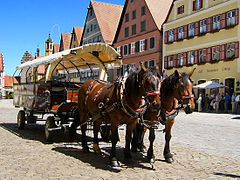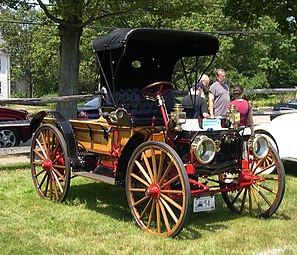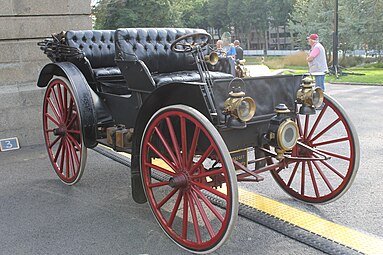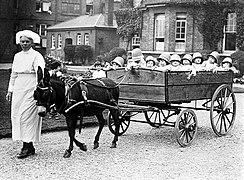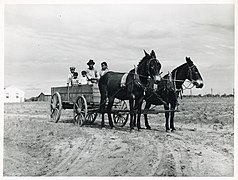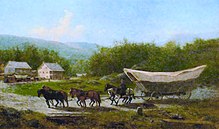
A sled, skid, sledge, or sleigh is a land vehicle that slides across a surface, usually of ice or snow. It is built with either a smooth underside or a separate body supported by two or more smooth, relatively narrow, longitudinal runners similar in principle to skis. This reduces the amount of friction, which helps to carry heavy loads.

A cart or dray is a vehicle designed for transport, using two wheels and normally pulled by draught animals such as horses, donkeys, mules and oxen, or even smaller animals such as goats or large dogs.

A carriage is a two- or four-wheeled horse-drawn vehicle for passengers. Second-hand private carriages were common public transport, the equivalent of modern cars used as taxis. Carriage suspensions are by leather strapping or, on those made in recent centuries, steel springs. Two-wheeled carriages are usually owner-driven.

A buggy refers to a lightweight four-wheeled carriage drawn by a single horse, though occasionally by two. Amish buggies are still regularly in use on the roadways of America. The word "buggy" has become a generic term for "carriage" in America.

The Conestoga wagon, also simply known as the Conestoga, is an obsolete transport vehicle that was used exclusively in North America, primarily the United States, mainly from the early 18th to mid-19th centuries. It is a heavy and large horse-drawn vehicle which, while largely elusive in origin, originated most likely from German immigrants of Pennsylvanian Dutch culture in the Province of Pennsylvania in the early 18th century. The name "Conestoga Wagon" probably derived from the Conestoga River Valley settlement area in the province and saw usage as early as 1717, although it is not known whether the first wagons referred as such had similar builds as later Conestoga wagons.

A horsecar, horse-drawn tram, horse-drawn streetcar (U.S.), or horse-drawn railway (historical), is an animal-powered tram or streetcar.

A limber is a two-wheeled cart designed to support the trail of an artillery piece, or the stock of a field carriage such as a caisson or traveling forge, allowing it to be towed. The trail is the hinder end of the stock of a gun-carriage, which rests or slides on the ground when the carriage is unlimbered.

Twenty-mule teams were teams of eighteen mules and two horses attached to large wagons that transported borax out of Death Valley from 1883 to 1898. They traveled from mines across the Mojave Desert to the nearest railroad spur, 165 miles (266 km) away in Mojave. The routes were from the Harmony and Amargosa Borax Works to Daggett, California, and later Mojave, California. After Harmony and Amargosa shut down in 1888, the mule team's route was moved to the mines at Borate, 3 miles (5 km) east of Calico, back to Daggett. There they worked from 1891 until 1898 when they were replaced by the Borate and Daggett Railroad.
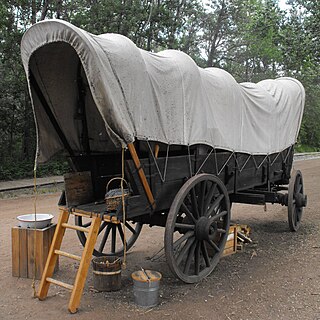
A covered wagon, also called a prairie wagon, whitetop, or prairie schooner, is a horse-drawn or ox-drawn wagon with a canvas top used for transportation or hauling. The covered wagon has become a cultural icon of the American West.

An oxOKS, also known as a bullock, is a bovine, trained and used as a draft animal. Oxen are commonly castrated adult male cattle; castration inhibits testosterone and aggression, which makes the males docile and safer to work with. Cows or bulls may also be used in some areas.
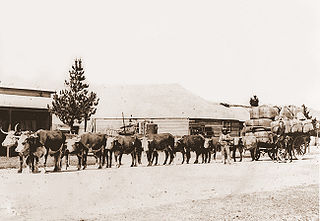
A working animal is an animal, usually domesticated, that is kept by humans and trained to perform tasks instead of being slaughtered to harvest animal products. Some are used for their physical strength or for transportation, while others are service animals trained to execute certain specialized tasks. They may also be used for milking or herding. Some, at the end of their working lives, may also be used for meat or leather.
A gun carriage is a frame or a mount that supports the gun barrel of an artillery piece, allowing it to be maneuvered and fired. These platforms often had wheels so that the artillery pieces could be moved more easily. Gun carriages are also used on ships to facilitate the movement and aiming of large cannons and guns. These are also used in the funeral procession of any higher authority of any state and country.

A bullock cart or ox cart is a two-wheeled or four-wheeled vehicle pulled by oxen. It is a means of transportation used since ancient times in many parts of the world. They are still used today where modern vehicles are too expensive or the infrastructure favor them.

A horse-drawn vehicle is a piece of equipment pulled by one or more horses. These vehicles typically have two or four wheels and were used to carry passengers or a load. They were once common worldwide, but they have mostly been replaced by automobiles and other forms of self-propelled transport but are still in use today.

An ox-wagon or bullock wagon is a four-wheeled vehicle pulled by oxen. It was a traditional form of transport, especially in Southern Africa but also in New Zealand and Australia. Ox-wagons were also used in the United States. The first recorded use of an ox-wagon was around 1670, but they continue to be used in some areas up to modern times.
The following outline is provided as an overview of and topical guide to transport:

Driving, when applied to horses, ponies, mules, or donkeys, is a broad term for hitching equines to a wagon, carriage, cart, sleigh, or other horse-drawn vehicle by means of a harness and working them in this way. It encompasses a wide range of activities from pleasure driving, to harness racing, to farm work, horse shows, and even international combined driving.

Breeching ( "britching") is a strap around the haunches of a draft, pack or riding animal. Both under saddle and in harness, breeching engages when an animal slows down or travels downhill and is used to brake or stabilize a load.

A float is a form of two-wheeled horse-drawn cart with a dropped axle to give an especially low load-bed. They were intended for use by deliverymen and the carrying of heavy or unstable items such as milk churns.
The wheel in Africa was used, to various extents, throughout the history of Africa. While it may have been common for Africans to manually carry their goods or use pack animals to transport economic goods in Africa, there was broad awareness, knowledge, and use of wheeled transports in Africa. However, the environment in some parts of tropical Africa, as well as alternative forms of travel and transport, such as via canoe and beasts of burden/riding animals, may have resulted in decreased use of animal-drawn wheeled transport in Africa. The wheel was also given other technical applications in Africa, such as a water wheel and a potter's wheel.






















